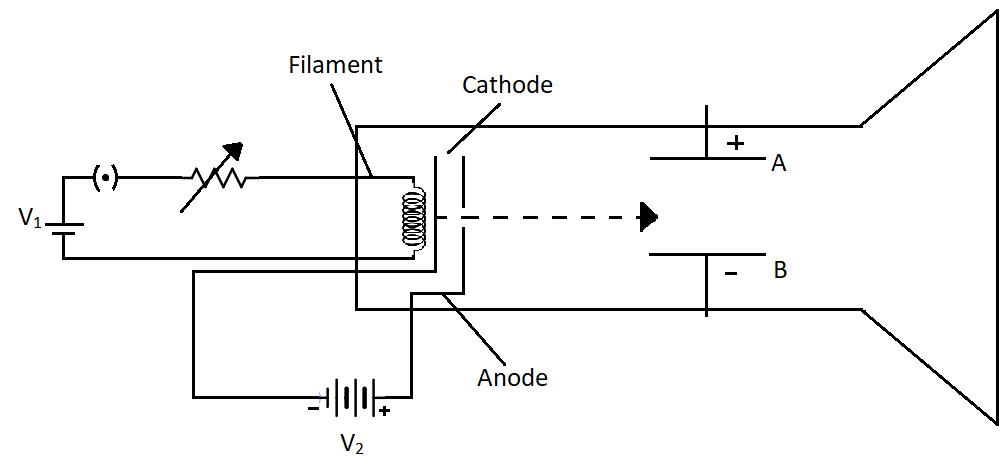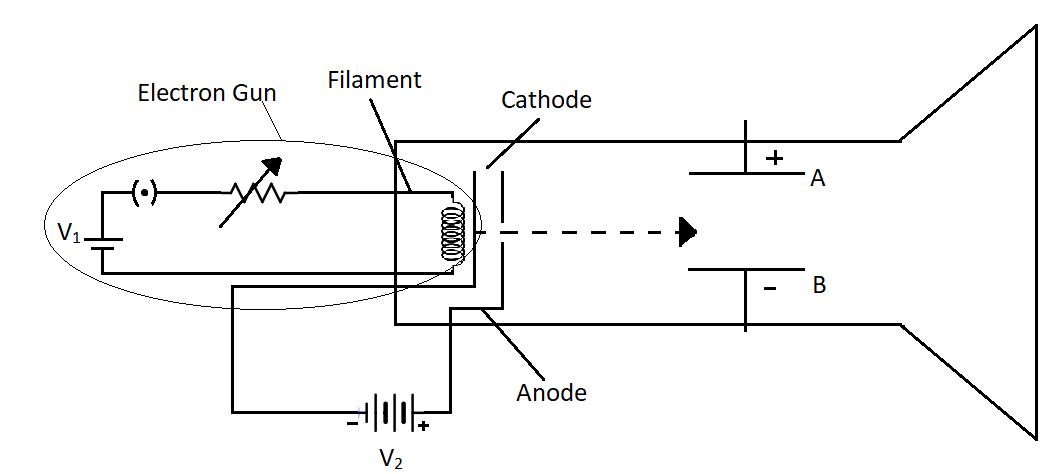
The diagram below shows a cathode ray tube in which the arrow indicates a beam of charged particles approaching an electric field between the plates

(A) Electron
(B) Proton
(C) Neutron
(D) Alpha

Answer
491.7k+ views
Hint
To solve this question we need to be well aware of the function and the workings of the cathode ray tube. If we break down the structure of the tube into various smaller parts we will see that it consists of the electron gun, which causes the release of the charged particles in the cathode ray tube. So these are the charges particles which are passing through
Complete Step by Step Solution
To understand the question we first need to understand what a cathode ray tube (CRT) is. The CRT is essentially made up of the four important parts-
-the electron gun
-the anodes
-the deflection plate
-the evacuated glass envelope.

The narrow part on the base of the CRT is called the electron gun. On turning the switch on, it produces a stream of electrons through thermionic emission. The deflection plates are present so that the stream of electrons coming out of the electron gun through the slit in the accelerating anode moves in a straight line to the screen, where they produce a bright spot.
Therefore the charged particles are coming out of the electron gun and are moving towards the electric field between the plates
So the correct answer is option (A).
Note
The cathode ray tubes have a wide range of uses. They are mainly used in several electrical devices such as computer screens, television sets, radar screens, etc. and also in various medical and scientific purposes. But the uses of cathode ray tubes have quite declined since the introduction of LCDs.
A few other advantages of CRTs are:
-Maintains good brightness
-has a long life
-excellent viewing angle, etc
To solve this question we need to be well aware of the function and the workings of the cathode ray tube. If we break down the structure of the tube into various smaller parts we will see that it consists of the electron gun, which causes the release of the charged particles in the cathode ray tube. So these are the charges particles which are passing through
Complete Step by Step Solution
To understand the question we first need to understand what a cathode ray tube (CRT) is. The CRT is essentially made up of the four important parts-
-the electron gun
-the anodes
-the deflection plate
-the evacuated glass envelope.

The narrow part on the base of the CRT is called the electron gun. On turning the switch on, it produces a stream of electrons through thermionic emission. The deflection plates are present so that the stream of electrons coming out of the electron gun through the slit in the accelerating anode moves in a straight line to the screen, where they produce a bright spot.
Therefore the charged particles are coming out of the electron gun and are moving towards the electric field between the plates
So the correct answer is option (A).
Note
The cathode ray tubes have a wide range of uses. They are mainly used in several electrical devices such as computer screens, television sets, radar screens, etc. and also in various medical and scientific purposes. But the uses of cathode ray tubes have quite declined since the introduction of LCDs.
A few other advantages of CRTs are:
-Maintains good brightness
-has a long life
-excellent viewing angle, etc
Latest Vedantu courses for you
Grade 11 Science PCM | CBSE | SCHOOL | English
CBSE (2025-26)
School Full course for CBSE students
₹41,848 per year
Recently Updated Pages
Master Class 11 Economics: Engaging Questions & Answers for Success

Master Class 11 Business Studies: Engaging Questions & Answers for Success

Master Class 11 Accountancy: Engaging Questions & Answers for Success

Master Class 11 English: Engaging Questions & Answers for Success

Master Class 11 Computer Science: Engaging Questions & Answers for Success

Master Class 11 Maths: Engaging Questions & Answers for Success

Trending doubts
State and prove Bernoullis theorem class 11 physics CBSE

1 ton equals to A 100 kg B 1000 kg C 10 kg D 10000 class 11 physics CBSE

State the laws of reflection of light

One Metric ton is equal to kg A 10000 B 1000 C 100 class 11 physics CBSE

Difference Between Prokaryotic Cells and Eukaryotic Cells

1 Quintal is equal to a 110 kg b 10 kg c 100kg d 1000 class 11 physics CBSE




